
课件48张PPT。动词不定式To do that sort of thing is foolish。I want to see you this evening.All you have to do is to finish it quickly. We found a house to live in.She came here to study English. I warned the patient not to eat cold water after the operation. 主语 宾语表语 定语 状语 宾补 不定式或不定式短语可起名词,形容词和副词的作用,在句中做主语,宾语,表语,定语,状语和宾语补足语。 一,不定式在句中的作用: 1、主语:不定式做主语时,可以直接放在谓语动词之前。 eg: To make a new dress takes her a lot or time. Not to get there in time is your fault. 注:常用it做形式主语,将to do放在位于之后,使句子保持平衡。句型1:It + 谓语 + to do eg: It takes us an hour to get there by bus. 句型2:It’s + n. + to do eg: It’s our duty to help the poor. 句型3:It is adj. for/of sb. to do sth. 注:for/of sb to do sth 为不定式复合结构。 1) of引起的复合结构只能做主语。 eg: It’s very kind of you to help me.2) for引起的复合结构在句中可做主语,宾语,表语,定语,状语等。 eg: Another method is for them to leave at once. (表语) We’d better find some work for the children to do. (定语) He put the paper on desk for you to read. (状语) What he told her made it impossible for him to go on her work. (宾语) It’s common for leaves to fall form the trees in autumn. (主语)2、做表语:主语+系动词+不定式 1). 其主语多为抽象名词(wish, need) eg: My wish is to be a scientist. The main thing is to keep our room clean. 2). 不定式to let, to blame, to seek做表语,主动表被动. eg: The house is to let. 3). be to do可构成将来时态,表 “准备/打算/计划/需要”; be是助动词,无词义,其主语为具体名词(人/事物); to be可用be going to或will/shall代替,此时不定式是谓语的一部分,而不是表语. eg: She is to return next week. It was about to leave when it started to rain.3. 做定语: 不定式做定语总是放在它所修饰的名词之后,不定式表示的行为通常是未来的行为,它们常和被修饰的词有动宾关系,主谓关系和修饰性关系. 1). 动宾关系: I have a lot of work to do. Give me a piece of paper to write on. 2). 主谓关系: She is the best person to finish the work. Women and children were the first to get into the lifeboat. 3). 修饰性关系(同位),它所修饰的词多为抽象名词. need, time, way, right, chance, courage, reason, wish, movement. eg: There is no need for him to come. He has no time to read the book.4. 做状语: 1). 目的状语: 可放于句首,也可放于句末, 前面可加in order/so as/so…as to表强调. eg: He went to see the artist himself. He stopped to have a look. He ran so fast as to get to school in time. 2). 结果状语:主要用在enough to/too…to…/only to结构中。 eg: The question is too difficult to answer. They worked hard enough to finish their work.3). 原因状语: 主语+系动词+adj.+ to do a). 表感情的adj.有: happy, surprised, pleased, glad, sorry, anxious(忧虑), disappointed, careful, afraid, wrong. eg: I’m very sorry to see you. He was afraid to leave him home. b). 说明句中主语在哪个方面存在形容词所表示的情况时,即与句中主语构成逻辑上的动宾关系,主动表被动. interesting, difficult, easy, important, possible, expensive, dangerous, useful. eg: The questi ... ...
~~ 您好,已阅读到文档的结尾了 ~~

